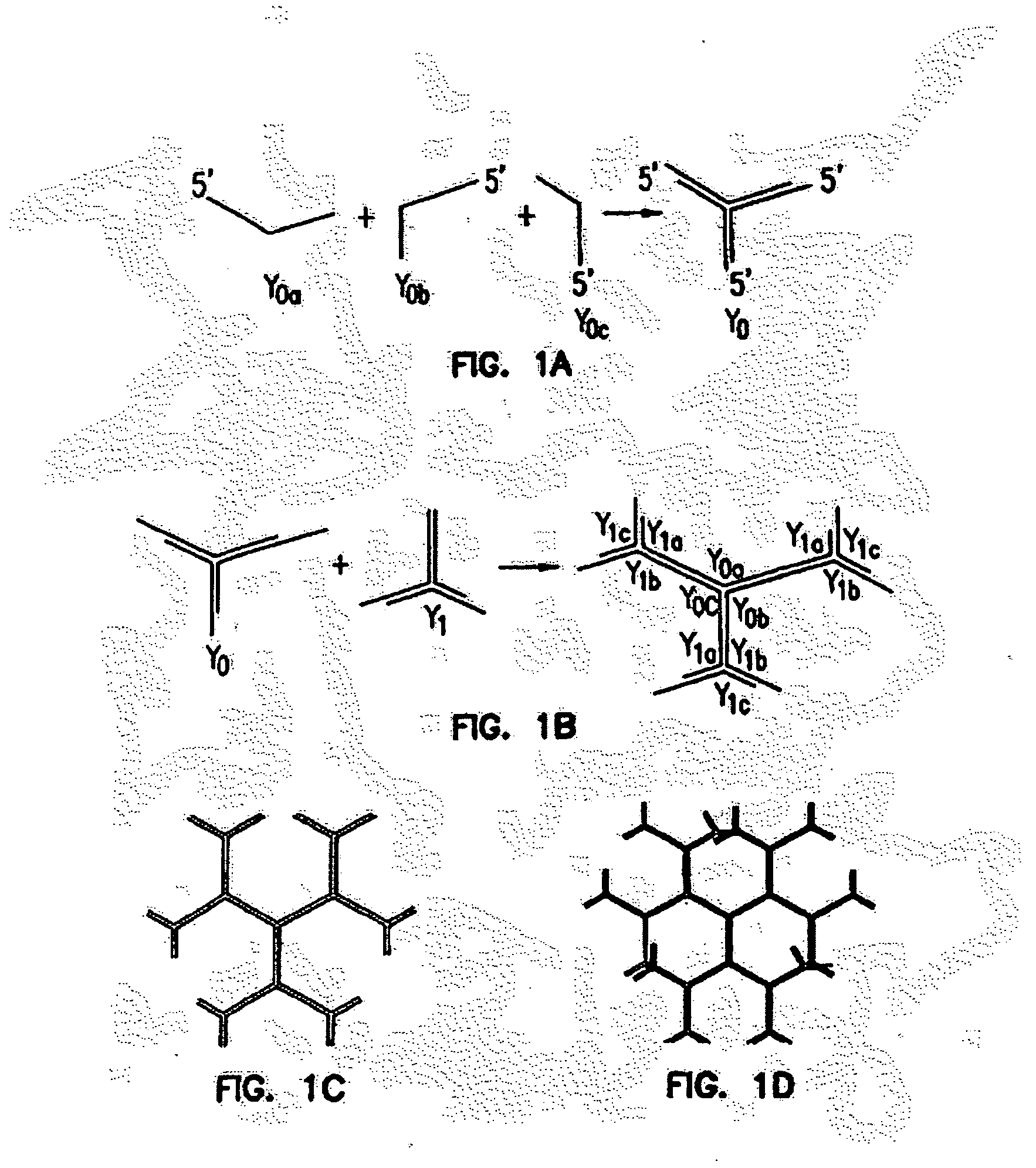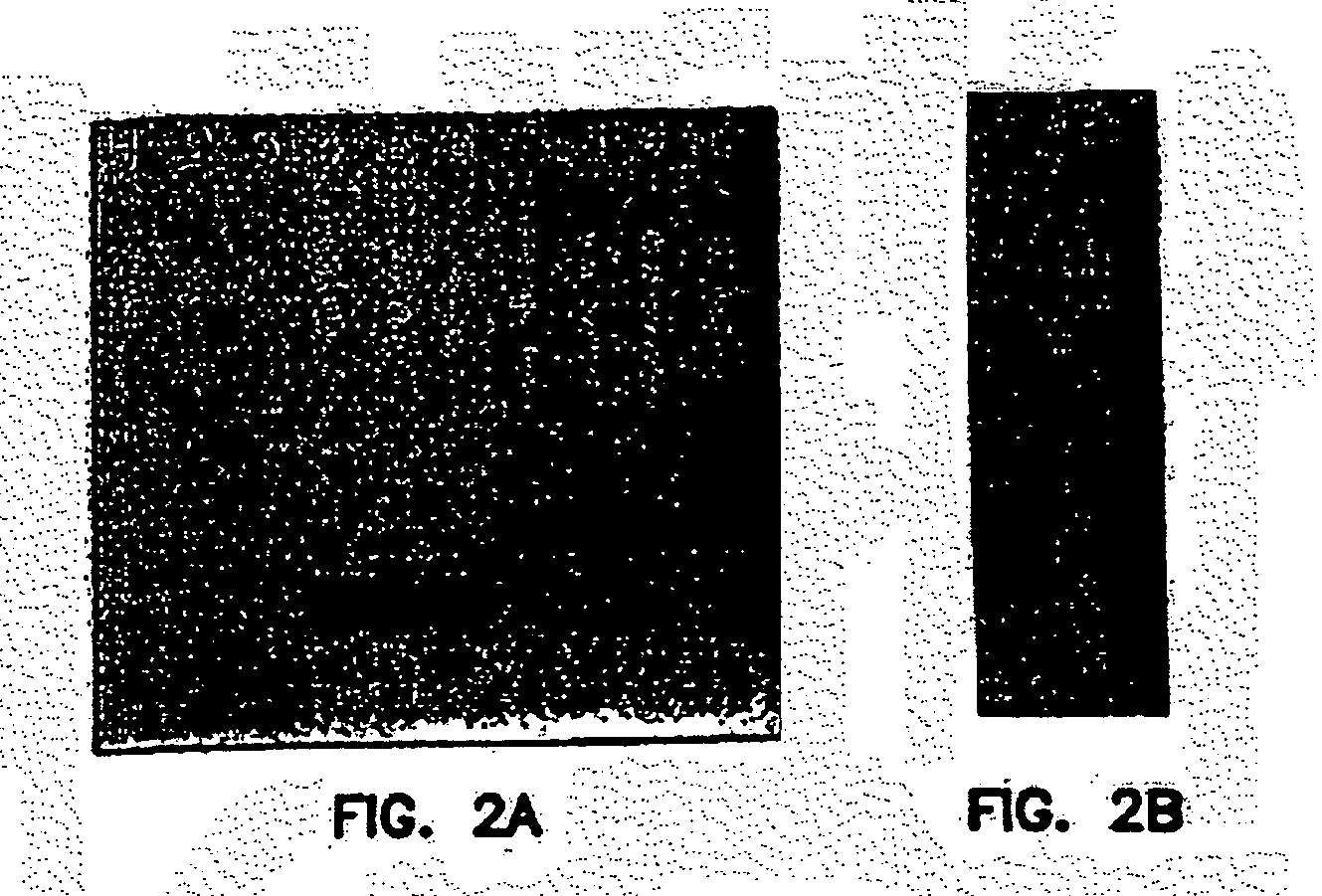Dendrimer-like modular delivery vector
a delivery vector and dendrimer technology, applied in the field of nucleic acid-based polymeric structures, can solve the problems of limiting the utility of dna materials in constructing dna materials, reducing the stability of rna, and still affecting the design and production of dna-based materials, etc., and achieves the effect of simple and robus
- Summary
- Abstract
- Description
- Claims
- Application Information
AI Technical Summary
Benefits of technology
Problems solved by technology
Method used
Image
Examples
example 1
[0288]The sequences of the strands, shown in Table 1, were designed according to the standards set by Seeman (Seeman, J Biomol Struct Dyn 8:573-81 (1990), which is hereby incorporated by reference in its entirety) and commercially synthesized (Integrated DNA Technologies, Coralville, Iowa). All oligonucleotides were dissolved in annealing buffer (1 OmM Tris, pHS. 0.50 mM NaCl, 1 mM EDTA) with a final concentration of 0.1 mM.
[0289]Y-shaped DNA (Y-DNA) were synthesized by mixing equal amounts of three oligonucleotide strands. (see FIG. 1A; also as described above, supra, Y-Shape). All the mixtures were first incubated at 95° C. for 2 mM, then quickly cooled to 60° C., and finally slowly cooled to 4° C.
[0290]Annealing Program:
ControlblockLid105° C. (Denaturation)95° C.2 min(Cooling)65° C.2 min(Annealing)60° C.5 min(Annealing)60° C.0.5 min Temperature increment −1° C.(number of cycle)go to (5) Rep 40(Hold) 4° C.enter
[0291]In one embodiment, Y-DNAs are the basic building blocks for the ...
example 2
Design, Construction, and Evaluation of Dendrimer-Like DNA using Y-DNA
[0294]For constructing DL-DNA, individual Y-DNAs were ligated specifically to other Y-DNAs, without self-ligation. The ligations were performed with Fast-Link DNA Ligase (Epicentre Technologies, Madison, Mi.). T4 DNA ligase may also be used (Promega Corporation, Madison, Wis.). The reaction scheme is shown in FIGS. 1B and 1C. The nomenclature of DL-DNA is as follows: the core of the dendrimer, Yo, is designated as Go, the 0 generation of DL-DNA. After Yo is ligated with Y1, the dendrimer is termed the 1st generation of DL-DNA (GI), and so on. The nth generation of DL-DNA is noted as G.
[0295]As noted above, each Y-DNA is composed of three single DNA strands (Table 4). These strands are designed so that ligations between Yi and YY can only occur when i (no self-ligation). In addition, the ligation can only occur in one direction, that is, Yo→Y1→Y2→Y3→Y4. In other words, when Y0 is ligated to Y1 with 1:3 stoichiometr...
example 3
Atomic Force Imaging of DL-DNA
[0298]A 5 ul DNA sample was placed onto the surface of freshly cleaved mica (Ted Pella, Redding, Calif.) functionalized with aminopropyltriethoxysilane (APTES, Aldrich) and allowed to adsorb to the mica surface for approximately 20 minutes. The mica was then rinsed in Milli-Q water and dried with compressed air. Images were taken in air using Tapping mode on a Dimensions 3100 Atomic Force Microscope (Digital Instruments, Santa Barbarra, Calif.), and the amplitude setpoint was adjusted to maximize resolution while minimizing the force on the sample. Briefly, the amplitude setpoint was increased until the tip disengaged the surface, and then decreased by 0.1 to 0.2 volts such that the tip was engaged and applying the minimal force onto the sample surface. Images were processed with a flattening filter.
[0299]As noted by high-resolution agarose gel electrophoresis, different generations of dendrimers were assembled from basic Y-DNA building blocks. To confi...
PUM
| Property | Measurement | Unit |
|---|---|---|
| Time | aaaaa | aaaaa |
| Time | aaaaa | aaaaa |
| Time | aaaaa | aaaaa |
Abstract
Description
Claims
Application Information
 Login to View More
Login to View More - R&D
- Intellectual Property
- Life Sciences
- Materials
- Tech Scout
- Unparalleled Data Quality
- Higher Quality Content
- 60% Fewer Hallucinations
Browse by: Latest US Patents, China's latest patents, Technical Efficacy Thesaurus, Application Domain, Technology Topic, Popular Technical Reports.
© 2025 PatSnap. All rights reserved.Legal|Privacy policy|Modern Slavery Act Transparency Statement|Sitemap|About US| Contact US: help@patsnap.com



